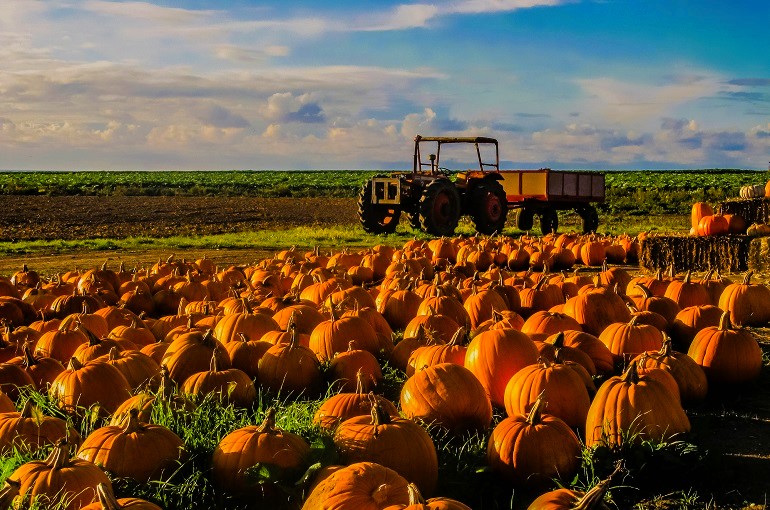Pumpkin Yield, Harvest and Storage

This post is also available in:
This post is also available in:
![]() Español (Spanish)
Español (Spanish) ![]() हिन्दी (Hindi)
हिन्दी (Hindi) ![]() Ελληνικά (Greek)
Ελληνικά (Greek) ![]() Português (Portuguese (Brazil))
Português (Portuguese (Brazil))
How much a pumpkin field can yield
Pumpkin producers report that they can produce 12-40 tons of pumpkins per hectare (11000-36000 lbs per acre). The yield depends on the variety of the pumpkin cultivated, the planting distances, the environmental conditions and the lack of any biotic and abiotic stresses during the growing period. In commercial pumpkin farms, we may expect to harvest 1 or 2 full-size pumpkins per plant (smaller or ornamental pumpkins may produce 8-10 fruits per plant).
When and How to harvest pumpkins
Most pumpkin varieties reach full maturity and are ready to be harvested 100-150 days after sowing (or 45-55 days after flowering). At that point, they are fully mature and have the optimum color and size of their variety, while the pumpkin skin (rind) should be firm/hard. Some farmers may also check the stalk (when mature, it becomes corky and cracked) or/and open a couple of fruits to observe the flesh color and texture. It is essential to harvest the fruits when they are fully matured; otherwise, they have reduced quality and storability.
Due to the differentiation in pollination time, not all pumpkins mature at the same time. Thus, we may have to harvest the same field more than one time. To avoid losses or quality deterioration, it is crucial to complete harvesting before the first autumn frost. Pumpkins can only be harvested by hand. We must be cautious about cutting and not pulling the pumpkin. Harvesting is usually performed by hand using a sharp knife or pruning shears. It is best to leave 3-5 inches (7.6-12.7 cm) of stem/stalk attached to the fruit to increase storability and facilitate their handling. Since some pumpkin varieties may have sharp prickles on their stems, the farmers are advised to wear protective gloves when harvesting.
Post-harvest handling of pumpkins
After harvesting, pumpkins are often washed and cured for 10-20 days. During curing, the pumpkins are placed in a well-ventilated area at 75-85°F (24-30°C) and 80-85% relative humidity. This process tends to extend the storage life of the product. Then the fruits are usually stored for 2-6 months at 50-70% relative humidity, good ventilation, and 50-55 °F (10-12°C). Some varieties can be stored longer than others. We must try to inspect our stored pumpkins often and remove any infested or rotting fruits. Depending on the pumpkin type and size, they can be packed and transported in bulk containers (22L or 36L), cartons, netted bags, plastic bins, or wire crates. In some cases, pumpkins may be pre-cut and sold in pieces (fresh or steamed)
References
- https://web.extension.illinois.edu/pumpkins/growing.cfm
- https://www.dpi.nsw.gov.au/__data/assets/pdf_file/0004/311485/Pumpkin-production.pdf
- https://extension.psu.edu/pumpkin-production
- https://extension.usu.edu/yardandgarden/research/pumpkins-in-the-garden
- https://zaszambia.wordpress.com/2021/10/02/ultimate-pumpkin-cultivation-guide/
- https://www.agric.wa.gov.au/pumpkin/growing-pumpkins-western-australia?nopaging=1
Read more
15 Interesting Facts about Pumpkins
Pumpkin Nutritional Value and Health Benefits
Growing Pumpkins in Your Backyard
Plant Information and Variety Selection of Pumpkins
Soil Requirements, Soil Preparation and Planting of Pumpkin
Growing Pumpkins Outdoors for Profit – Complete Growing Guide from Start to Finish
Pumpkin Yield, Harvest and Storage
Common Pumpkin Pests, Diseases, and Weed control








































































